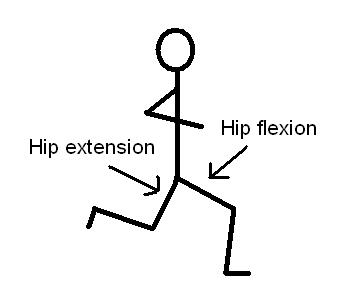
There is no doubt that as I read my way through a dozen or more running books and a few hundred academic journal articles that I’ve had to sharpen up my knowledge of the human body and what makes it move. The muscles and their role in propelling the body over the ground was not something I had given a great deal of thought. Like me, you need a little bit of basic knowledge here to help get conscious control of your running technique.
We need to cover a little bit of science. But bear with me, I’ll use a minimal amount of scientific jargon and where I do, I’ll include a plain English explanation in-text. But you will need to grasp some core concepts; this will be useful in improving your running and in communicating with health professionals such as physiotherapists. If you can speak their language and describe your nagging injuries specifically, you’ll likely resolve any issues quicker than relying on a one-way diagnosis. You’ll understand the instructions they may give around treatment; rehabilitation and ongoing strengthening you may require to avoid re-injury.
I’m not saying you need to be an anatomy professor, but getting your hands on a basic anatomy text is a decent investment for someone interested in the sport of running. The one I often refer to is called the “Pocket Atlas of the Moving Body” by Mel Cash (2000). I picked this up about eight years ago when I was completing a gym instructor qualification. It’s only about sixty pages long, full of diagrams and easy to understand tables that describe how they body hangs together and which muscles are responsible for initiating various movements.
If you can’t get your hands on this, there’s plenty of information on the Internet, just be careful you only rely on reputable sources. I’ll summarize the basics for you in this chapter so we’re all talking the same language as we progress through this book.
Why we need to cover some anatomy. It’s unavoidable otherwise we can’t communicate, if I stick to recognised terms it will allow me to consistently describe concepts, and for you to be confident that you understand exactly what I’m talking about. I’ll use the minimum amount of technical language and hopefully zero jargon. To help you out, I’ll include a plain English explanation as often as possible to save you the trouble of looking up definitions. In some cases this may feel like I’m over-explaining but I think it will help, especially on your first read.
There are five main concepts you need to
understand to comprehend how running works. This is an over
simplification, but it describes the main movements and joints
involved. These are:
1. extension and flexion of the hip joint;
2. extension and upright posture of the back;
3. abduction and outward rotation of the hip joint;
4. flexion and extension of the knee joint; and
5. dorsiflexion and plantaflexion of the ankle and foot.
Movement at the hip joint
Hip extension. The primary movement in running is sourced from the centre of the body: the hip joint where the thigh joins the pelvis. I’ll talk about this in much more depth in the coming chapters. The two movements we are most concerned with in running are extension and flexion of the hip. Firstly, the extension of the hip joint: the thigh bone (femur) being pulled towards and then slightly pushed behind the body.
The main muscles involved in extending (and stabilising) the hips are the buttocks and hamstrings. The buttocks being comprised of: Gluteus Maximus, Medius and Minimus. Where I use the words glutes and buttocks I am referring to the same muscle group. Interestingly, the thigh bone only extends a very small way behind the body during running. This becomes important later when we discuss optimal technique, because these prime-movers of running can only extract a small range of motion behind the body, the runner needs to aim for ideal positioning of the hip, knee and foot to extract maximum leverage and power from each stride by engaging the hip extensors and knee flexors before the foot contacts the ground.
When I talk about extending the hip joint, this encapsulates movement that retrieves the leg and thigh from ahead of the body mass (flexion) and moves it towards the body and the extended position. So even though technically the hip joint is still flexed, it is extending because it is reducing the amount of flexion at the hip.

Hip flexion. Secondly, the hip joint flexes: placing the thigh and leg ahead of the body’s mass. Lifting your leg up a flight of stairs or kicking a ball involves flexing the hip joint. The main muscles involved in flexing the hip are:
Hip flexors of the leg: Rectus Femoris, Sartorius, Pectineus and Tensor Fascia Lata. These muscles work from the front of the pelvis to the thigh bone and shin.
Deep hip flexors of the core and spine: Iliacus and Psoas. These muscles work from the spine and inside of the pelvis to the thigh.
I will argue throughout this book that it is hip extension that is the most important phase of running and the hip flexion comes about as a product of, and stored energy reaction to, powerful hip extension and to a lesser extent knee flexion. *Note: as a ball and socket type joint the hip has a wide range of moves and motion. I’ve covered the basics here to keep things simple.
Hip abduction and external rotation. The ability of the hip to abduct (take the leg away from the body) and to rotate outwards are two movements not often mentioned in running. The importance of this ability is perhaps not understood and definitely not well explained. One of the main problems with runners’ techniques is that they tend to run along an imaginary midline to the body i.e. if you drew a line along the ground, many runners would be able to run that line with both their feet contacting the line on each stride. This is an unstable and weak position: I’ll talk much more about this later.
To avoid this problem you need to be able to slightly abduct and rotate the hip outwards. Both these actions help to bring the thigh into alignment with and under the hip joint. This is needed because of the propensity of the thigh to track inwards during the forward swing phase of running (possibly under the influence of the hip flexors Iliacus and Psoas which attach onto the inside of the thigh). In my view this may in fact be a technical flaw - certainly it is something I've been striving to eradicate from my own running. An alternative view is that if the glutes, spinal erectors and core are strong enough, the thigh will be prevented from rotating inwards much at all, thereby always maintaining optimal posture. This position enhances power, stability and influences optimal foot placement to prevent instability around the ankle and twisting through the tibia (shin bone).
The main muscles involved in abducting and externally rotating the hip are: Gluteus Maximus; Gluteus Medius, Gluteus Minimus and Piriformis.
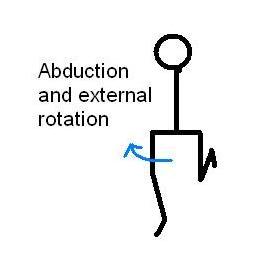
Stability and posture of the spine. One of the things runners often forget is the role of maintaining good posture through the spine while running. It is a consequence and perhaps even a cause of a powerful hip extension and strength in the hips and buttocks. The Gluteus Maximus, in addition to extending the hip also plays a role in extending (straightening) the lower back. The best runners float above the hips, their torso upright with a good concave curve in the lower spine that indicates excellent glute activation and strength in the spinal erectors. This posture also helps enable a faster transition into hip extension: more about this later.
Movement at the knee joint
Flexion of the knee. The primary movement at the knee joint is flexion: the knee is in a tightly flexed position when the foot is drawn close to the buttocks. The maintenance of knee flexion in running is one of the most critical elements of good technique; it prevents over striding, absorbs shock and adds power to each stride. The flexion of the knee also shortens the leg so the transition to hip flexion is made more easily and quickly during the swing phase of running.
The main muscles involved in flexing and maintaining flex in the knee are: the hamstrings and the large calf muscles (gastrocnemius). The hamstrings are the primary knee flexors. The calf however plays an important role in maintaining knee flexion just before and during ground contact.
A number of other muscles play a smaller role in knee flexion, although this is likely to be more about maintaining flexion, stability and stiffness around the knee joint. These muscles are: Sartorius and Gracillis, two muscles that traverse and run down the inside of the thigh respectively and attach onto the Tibia (shin bone). The Popliteus and Plantaris muscles are also minor knee flexors that can be injured by over extending (straightening) the knee.
There is also a strong argument that can be made that the Gluteus Maximus via its attachment to the Iliotibial band (that runs down the outside of the thigh) and ultimately the Fibula (smaller and lateral lower leg bone) also acts upon the knee joint: maintaining stiffness and stability as the hip extends and also storing and releasing energy. You will notice with many elite runners an obvious flare outwards of the knee when they are in contact with the ground. I believe strong activation of the buttock muscles causes this.
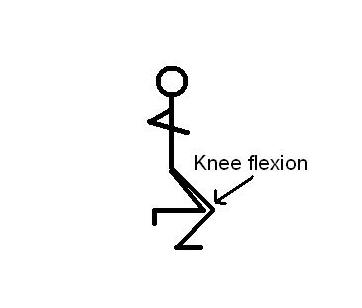
Extension of the knee. The secondary movement at the knee joint is extension: the straightening of the knee. In running the extension of the knee is the result of the previous flexion and is an elastic unfurling of the lower leg during the later phase of the swing cycle.
The main muscles involved in extending the knee are Rectus Femoris and the Quadriceps (Vastas Lateralis, Intermedialis and Medialis). The primary muscle involved in extending (straightening) the knee during running is the Rectus Femoris. The vastus group of muscles is mainly active to stabilise and stiffen the knee preventing it from collapsing during ground contact. This allows maximum force to be applied through the hamstrings and glutes during the support phase of running.
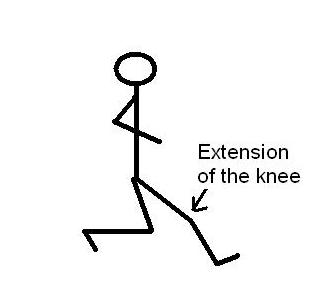
Movement at the ankle and foot
The ankles and feet move in a tremendously complex number of ways. I’ll briefly cover those movements most vital to effective running.
Dorsiflexion. The foot is pointed upwards. If you land on your heel the foot is likely to be held in a dorsiflexed position. The main muscles involved in dorsiflexion can be found on the front and outside of your lower leg where they originate, they then attach onto various structures and bones in the foot. These are: Tibialis Anterior, Extensor Digitorum Longus and Extensor Hallucis Longus.
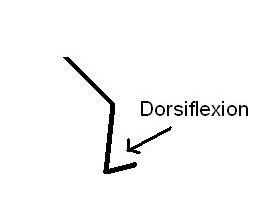
Plantaflexion. The foot is pointed downwards. If you land on your toes your foot is likely to be held in a plantaflexed position. The muscles involved in plantaflexion are: the Gastrocnemius, Soleus, Tibialis Posterior, Flexor Digitorum Longus, Flexor Hallucis Longus and Plantaris. These muscles are all found at the back of the lower leg, the Gastrocnemius is easily identifiable as the large calf muscle closer to the knee and the Soleus visible closer to the foot.
Plantaflexion is the movement that holds the ankle and foot stiff forming a solid platform for force to be exerted through the hip, knee and ankle joints to the ground and for stored energy in the muscles and tendons of the foot, achilles, calf, hamstrings and iliotibial band to be unleashed.
The Gastrocnemius originates from the lower thigh bone, crosses the knee and attaches onto the achilles tendon. The other muscle that attaches onto the Achilles is the Soleus which originates from the upper portions of the lower leg bones the Tibia and Fibula.
The other muscles involved in plantaflexion; Tibialis Posterior, Flexor Digitorum Longus and Flexor Hallucis Longus are found underneath the Soleus and Gastrocnemius in the deep compartment of the lower leg. These muscles originate from the upper portions of the tibia and fibula (lower leg bones) and attach via tendons underneath the foot and toes. They play a critical role in maintaining shape in the arch and the foot and are often overlooked as sources of foot pain i.e. the muscles become tight in the lower leg and refer pain into the foot via these tendons.
These smaller muscles play a large role in the stiffening of the foot and are the most likely beneficiaries of wearing minimal and flexible footwear because they are forced to strengthen to maintain foot stiffness otherwise provided by shoes.
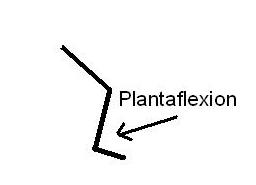
The neutral foot. The sole of the foot and toes are held more or less horizontally to the ground. The muscles responsible for plantaflexion enable to foot to stay strong and springy in this posture, allowing maximum transference of energy produced by the buttocks and hamstrings.
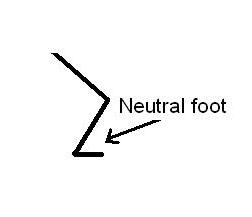
A little bit about pronation. Pronation is generally described as the ankle and foot rolling inwards and is thought by many people to be the source of almost all running injuries. You can guess that I don’t agree. Most people in the minimalist or barefoot running fraternity would probably be straight in my corner supporting me with that line of thought. This movement is also described as eversion of the ankle and is probably a better description of the negative elements of the phenomenon.
An alternative description of pronation I have read is the simple process of the foot flattening (to absorb shock and load energy) prior to stiffening (through plantaflexion) to transfer force into the stride. Pronation is therefore not a bad thing in itself: it is the analysis about what is excessive that becomes controversial and the root cause. Shoe manufacturers have been in the camp of those who claim this is a major problem that needs to be controlled by expensive shoe features.
Later in this book I’ll describe why movement and posture at the foot and ankle can be influenced by greater strength and control at the hips. The cause of this problem can be eliminated by greater strength and changes to technique: not by purchasing expensive motion controlling running shoes.
Movement at the pelvis. Without getting too technical there are also movements that need to be considered in running that occur at the pelvis. The pelvis has the ability to tilt forwards and backwards by a small amount which changes the position of the hip joint (the most important joint in running). I mentioned earlier that the range of motion of the thigh bone behind the body is very small; some authors believe that the action of the spinal erectors (lower back muscles) tilts the pelvis forward slightly allowing for greater range of motion behind the hip. There is also speculation that this action provides additional force to the stride (Bosch and Klomp, 2005). I’m less convinced about the force generation argument, as this is mostly driven by the buttocks and hamstrings. A more plausible explanation would be the spinal erectors helping to maintain an optimum posture about the pelvis to allow the hamstrings and glutes to exert maximal force and to achieve a good range of motion as the leg pushes behind the body. As a final word on this, further study is needed to explain the role of pelvic posture and tilt in optimal running technique.
Summary. I have provided this background information to allow you to more easily understand the rest of the content in this book. The process of understanding how running works is really an appreciation of how the joints and muscles need to be held in optimal position and activated in the correct pattern at the right time. Some of these concepts are slightly dry and a bit technical so I've added additional video and photographic resources to help explain things further.
****